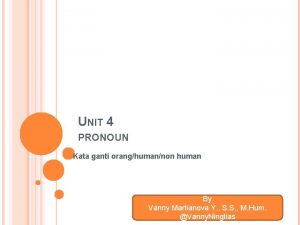Nonhuman Primates in Research in the US Analysis

- Slides: 1

Nonhuman Primates in Research in the US: Analysis of 2016 -2018 USDA Annual Animal Number Reports for Registered Research Facilities 1 Alanna Brownell, Yufan Ye, and Allyson J. Bennett 1 Psychology Department, Harlow Center for Biological Psychology, University of Wisconsin-Madison, WI 53715 Research within nonhuman primates (NHP) plays an important role in scientific and medical advances, including the prevention and treatment of diseases and other health threats. 1 In 2016, there were 71, 001 NHP in active research. There was increase of 1, 428 NHP in category C-E from 2016 to 2017, and a total decrease of 4, 025. From 2017 to 2018, there was a decrease of 1, 632 in C-E but a total increase of 410 NHP. 4 2016 Animal use is reported in four categories, along with the total number of animals in research which is the sum of the four 3 Roughly half of NHP in research were held in private companies from 2016 to 2018 Category C-E (NHP in research) Category B (NHP in facility, not in research) 71, 001 72, 429 70, 797 38, 632 33, 179 35, 221 Total 109, 63 105, 106, 018 3 608 30, 095 21, 861 27, 956 Imported (CDC) Understanding the number and distribution of NHP in research is of public interest and can inform decisions about practice and policy for captive animals. Research facilities submit an annual census report of NHP to the USDA. Other types of facilities make up 82% of all USDA certificate holders housing NHP but are not required to report a census. 2 2017 From 2016 to 2018, nearly 3/4 of NHP were used for non-invasive research, breeding, or holding. To account for ~96% of NHP housed in USDA research-registered facilities, the reports from the 27 facilities that house ~85% of NHP 5 and the 102 facilities that house ~11% of the remaining NHP were combined analyzed. 6 The annual NHP number reports are not a cumulative count of individuals over time. SUMMARY Our research presents an overview of the number of nonhuman primates in research in the US. Non-research facilities such as licensed exhibitors are not required to submit annual census reports. Thus, the collected data of NHP does not support a full analysis of NHP housed in the US, and the numbers here are underestimated. This analysis gives insight to the research animal capacity and the different modes of research and testing in which NHP are used. Academic facilities often use NHP for basic scientific studies to understand brain function, biology, genetics, immunology, behavior, and other aspects of health and development. 7 The use of NHP in private companies is more likely to develop and test the safety and efficacy of vaccines, drugs, and medical devices to treat human and Data Sources, Method, and Analysis 8 animal health. Bennett, Allyson J. , and Dario L. Ringach. “Animal Research in Neuroscience: A Duty to Engage. ” Neuron, vol. 92, no. 3, 2016, pp. 653– 657. , doi: 10. 1016/j. neuron. 2016. 10. 034. 1 Entities that engage in exhibition, breeding, dealing, or transporting species covered by the Animal Welfare Act (AWA) must be licensed by the United States Department of Agriculture (USDA). Data courtesy of Dr. Taylor Bennett. 3, 4 Each year the USDA posts a summary of the number of AWA-covered species by state. For the analyses reported here we downloaded summary data for 2016 -18. https: //www. aphis. usda. gov/aphis/ourfocus/animalwelfare/sa_obtain_research_facility_annual_report/ct_research_facility_annual_summary_reports 3 The USDA categories correspond to IACUC protocol designations and are defined in link above. 5, 7 The top 27 facilities that account for ~85% of all nonhuman primates in research were identified from Table 1 (p. 7) of the 2018 NIH ORIP report titled: "Nonhuman Evaluation and Analysis. Part 1: Analysis of Future Demand Supply. All. USDA registered research facilities must submit an annual report. 6 Each of the additional 102 facility reports were obtained from the following database link. https: //acis. aphis. edc. usda. gov/ords/f? p=118: 205: 0 8 Flier, J. S. (2019). Academia and industry: Allocating credit for discovery and development of new therapies. The Journal of Clinical Investigation, 129(6), 2172 -2174. https: //doi. org/10. 1172/JCI 129122 2

